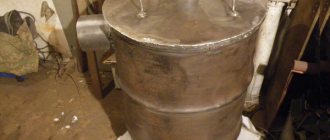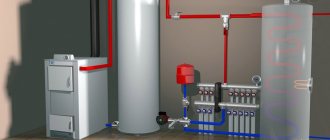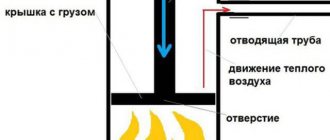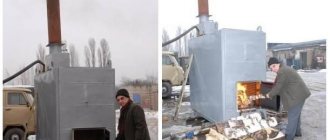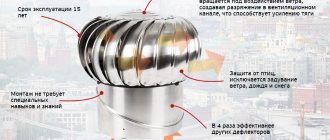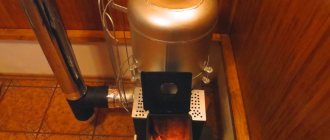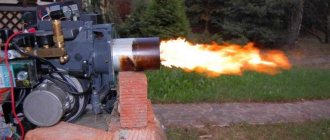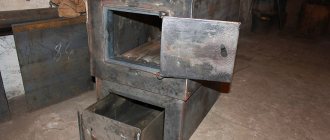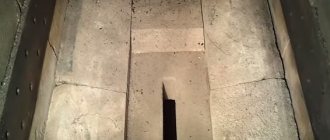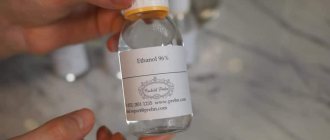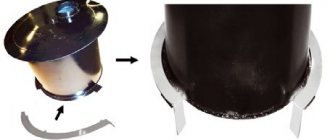Home / Solid fuel boilers
Back
Published: 08/10/2019
Reading time: 6 min
0
3776
Mine boilers (MC) with long-burning pyrolysis type or Kholmov boilers are one of the types of solid fuel heat generators. They belong to the class of energy-independent and efficient units, with forced or natural movement of the gas-air environment.
Typically, mine boilers are manufactured at industrial sites, however, today there are many designs made by hand by craftsmen in compliance with the requirements of regulations and standards in the field of manufacture and safe operation of boiler plants.
Many devices are equipped with energy-efficient features with an additional water heating circuit and storage tank.
- 1 Kholmov's boiler
- 2 The principle of operation of the boiler
- 3 Advantages and disadvantages
- 4 Manufacturing a mine pyrolysis boiler 4.1 Algorithm for creating a boiler with your own hands.
Kholmov's boiler
This modification of the stove is distinguished by the fact that it is equipped with two chambers - for installing a heat exchanger and separately for burning fuel. These devices feature bottom combustion and a full-height firebox, which became the name for them. The principle of operation depends on the design.
The most popular today are two designs:
- Kholmov pyrolysis boilers (PK);
- normal combustion.
The fuel burns at the bottom of the closed combustion space. The second shaft is smaller in size and is used to burn exhaust gases and cool them in the boiler for heating water.
Non-volatile devices control the temperature with an RT3 thermostat installed at the front of the structure. To ensure complete combustion of the fuel, the air supply to it is regulated by the blower door located on the main door of the ash pit.
Kholmov's boiler. Top and side view
A special restriction valve is installed to ensure minimal air passage. In the upper rear part of the unit there is a pipe for connecting a chimney that provides natural draft.
The boiler is equipped with a shut-off valve and compensators on the outside and inside the body, designed to prevent welds from breaking during emergency overheating.
Installation of a wood and coal mine-type boiler
Kholmov boiler design
A boiler of this type in its structure has the following main elements:
- frame;
- fuel loading chamber;
- chamber with heat exchanger;
- grate;
- doors;
- ash pit;
- expansion compensators;
- chimney pipe;
- outputs and inputs for drainage, supply and return, for attaching a safety group or safety valve;
- thermostat
Kholmov's solid fuel boiler with a power of 12 kW weighs almost 255 kg. Its dimensions: height – 124 cm, width – 48.5 cm, length – 66 cm. Moving this unit through a doorway will not cause difficulties. Boilers with a power of 10 kW are similar in appearance and size to the previous model, the only difference is in the design from the inside.
The upper doors of the unit are double; inside there is a thermal insulator, due to which the temperature does not rise above 80 °C. The edges are covered with sealant. Painted with temperature-resistant paint. The cover at the back is closed with four quick-release screws, and the others with special locks. The door of the ash chamber at the bottom is only 40% closed with a heat insulator, and the temperature does not rise above 90 °C due to cooling by constant air flows.
The lowest part of the heating unit is precisely a special plate with an internal thermal insulator and a pair of long legs, and not the bottom of the boiler shaft.
Such a device increases the efficiency of the Kholmov boiler and protects the heating system and the room from fire. Thus, the shaft boiler can even be installed on a wooden floor.
Energy-dependent units additionally have in their design a smoke exhauster or a fan, a controller for regulating the combustion process. However, boilers that do not require energy to operate are still more popular. In non-volatile devices, control is carried out by a RT3 thermostat. It is located on the wall in front. Using a chain, the thermostat and a small blower door are connected through a special eyelet.
The blower door is needed to supply oxygen to the unit in order to maintain fuel combustion in it at the proper level. It is located on the large door of the ash chamber. It is never completely closed, because a special gap is provided for minimal oxygen passage.
At the back, in the upper part, there is a pipe. A chimney is connected to it. Due to the pipe, natural traction is provided. Through the blower door, air begins to flow into the heating unit, which passes into the under-grid chamber with a pair of cast iron grates. Behind them there is a reserve welded grate (hump), which is located above the previous ones.
Under the grate there is a container for collecting ash. It can be easily removed when cleaning. To drain the liquid, there is a half-inch pipe at the bottom of the boiler; a similar one is intended for the safety group or safety valve.
Expansion compensators are designed to prevent expansion of the Kholmov boiler to emergency sizes and rupture of welds.
Expansion joints are located around the entire perimeter of the boiler. They are also found in the inner part of the case.
Operating principle of the boiler
The heat generation process occurs in two ways: direct combustion of natural fuel and afterburning of the pyrolysis gas mixture formed due to lack of air. Some of the fuel smolders, releasing smoke with tar and soot. Next, the gases migrate through the coals, becoming saturated with flammable components and turning into a gas-combustible mixture.
These shaft-type units have bottom combustion. The process is carried out at a level of 20.0 cm in the lower zone of the combustion chamber. The top fuel waits in the hot reserve until the bottom burns out. Flue gases are collected approximately 30.0 cm above the fuel.
The main volume of primary air falls under the grate and moves to the part of the unit for pyrolysis afterburning. It traps flue gases above the combustion level.
The shafts are separated by a partition with a small gap at the bottom, through which the flame is drawn by traction from the first chamber to the other, where complete combustion of flammable gases, washing the convection heat exchanger at T +850 C, is completed.
The heating circuit in the water jacket of a shaft-type boiler is subjected to radiation heating; the residual heat is transferred to a convection-type heat exchanger.
Advantages and disadvantages
The mine unit has the following main advantages:
- Versatility, availability of work on different types of fuel, including liquid for modified installations.
- High boiler efficiency, productivity and autonomy without additional fuel loading up to 24 hours.
- A well-thought-out design that simplifies maintenance; loading/unloading is carried out through separate hatches.
- Reliability and safety, therefore, indoor gas pollution and carbon monoxide poisoning can be said to be reduced to “zero”.
The disadvantages include:
- increased soot and tar formation during fuel combustion;
- huge dimensions of the installation.
Manufacturing of a mine pyrolysis boiler
Today, modified PCs are in great demand, with high efficiency, allowing to save a significant amount of fuel and functioning from one filling for more than a day. The simplicity of the design allows the boiler to be manufactured with even little experience in welding.
Drawing of an ordinary pyrolysis boiler
The basis for creating an effective Kholmov boiler with your own hands will be reliable design documentation: drawings, specifications and calculations, which today can be found on the Internet.
When choosing the desired drawing of the unit, pay attention to the loading volume of the device; the larger it is, the longer the operation will be and what the power of the heat generator depends on.
Algorithm for creating a boiler with your own hands.
- They make the main part of the device and divide it into two chambers, installing partitions and valves for air supply.
- The diagram of the parts is transferred to a metal sheet and cut out autogenously.
- The side elements are welded using a reinforced seam.
- Between the boiler and the firebox, 2 holes are cut in the partition - at the top and bottom near the grate.
- Install the furnace parts and scald them.
- Place the valve at the top hole and secure it.
- Grate bars are made with narrow longitudinal slits cut.
- The grate bars are placed on metal corners (cast iron) or welded (steel).
- The doors of the firebox and ash pan are made.
- A boiler made of 25 mm pipes with a water jacket is installed and scalded.
- They set up an afterburning chamber for the smoke-gas mixture by welding a partition next to the grate.
- A hole is made at the bottom to install a 50 mm air pipe with a blind damper at the outlet end and many holes to create a uniform air flow.
- The combustion chamber is insulated with chamotte, and then it is additionally insulated with basalt wool, which increases the thermal efficiency of the boiler unit.
- Next, they install the manufactured equipment, connect the water and smoke gas ducts, install the heating, and then pressurize the system.
Manufacturing the outer part of the boiler
The Kholmov boiler also requires external walls of the water jacket and doors. According to many videos, the further process of making a boiler involves the following actions:
- Cutting outer walls from metal . In this case they are simple rectangles. The back side measures 77x46.3 cm, the sides - 77x57.6 cm, and the front - 56.2x46.3 cm.
- Cutting 2 round or diamond-shaped compensation holes in the front wall . The diameter of the rounds is 1 cm. They are placed on the same vertical line. A 15mm hole is also made in the upper right corner. It is necessary for a thermometer.
- Cutting holes in the back wall . There are 2 compensation holes and 3 additional holes in it: the first is for the chimney, the second is for supplying coolant (diameter 40 mm), the third is for the drain valve (diameter 15 mm).
- Cutting 4 compensation holes in the side walls . In this case, one pair is placed in two walls so that it is in line with the water jacket compensator. Later you need to insert a metal rod into these holes and weld it. Two holes are drilled in the left side wall: the diameter of the first is 40 mm (needed to return the coolant), the second is 20 mm (for the thermostat).
- Manufacturing of U-shaped compensators . There should be 10 of them. Dimensions 4x4x3 cm (LxWxH).
- Welding expansion joints to expansion holes in external walls.
- Welding all external walls to the internal structure.
- Welding pipes and chimneys.
- Welding 4 bolts at the top of the structure . They are placed around the perimeter of the heat exchange chamber.
- Checking for leaks . To do this, put plugs on all pipes and pour water into the Kholmov boiler. Next, raise the pressure to 2.2 bar. The operating pressure of the device will be 1.5 Bar. All leaks are welded using electrode welding at high currents using water. This process can be seen in various videos.
- Bottom welding.
The best mine boilers
Pyrolysis-type ShKs are now in demand among the population living in one-story and two-story houses, since they have proven their effectiveness and demonstrated ease of operation.
The market responded quite quickly to customer requests and was filled with a wide variety of units from domestic and foreign manufacturers.
In online shopping ratings for 2021, the greatest demand is for units with service life of more than 20 years and innovative heating surfaces.
Main characteristics of mine boilers.
| Indicators | Pyrolysis 43 Kp-10 | Heiztechnik (12 kW | Wirbel ECO CK Plus 25 |
| Price | 67100 rub. | RUB 215,760 | 277845 rub. |
| Model | 66694 | 90128 | 80023 |
| Manufacturer | Pyrolysis 43 | Heiztechnik | Wirbel |
| Short description | Duration of work on 1 tab is up to 10 hours. Efficiency 85% to 90%. Energy intensity, low fuel consumption. Automatic heating temperature maintenance. | Power 12 kW, new EU product, innovative technology. Eco-friendly heating installation with an advanced burner with auto-ignition and a self-cleaning system. Efficiency - 91%, heating temperature - 85 C. | Universal unit for liquid and solid fuels. Range of heated medium – 40/90 C, efficiency on solid fuel – 85%, on liquid fuel – 90% |
| Power, kWt: | 10 | 12 | 25 |
| Weight, kg | 210 | 350 | 271 |
| Dimensions (HxWxD), mm | 1070x500x800 | 1370x1150x550 | 1260x915x1070 |
| Chimney diameter, mm | 160 | 150 | 160 |
| Manufacturer country | Russia | Poland | Germany |
Thus, to sum it up, we can say that shaft-type boilers are efficient devices with low specific fuel consumption. Such units are used today for individual heating of residential and public buildings, significantly reducing owners’ heating costs.
Instructions for making a Kholmov boiler with your own hands
Below are step-by-step instructions for creating a Kholmov boiler on your own. The power of the device that will be considered is 8-10 kilowatts.
In accordance with the drawings shown in the video below, the dimensions of the product will look approximately as follows:
- 0.8 meters in height;
- 0.47 meters wide;
- 0.576 meters deep (if you add a door with a neck, you get 0.63 meters).
Video - Solid fuel mine boiler
Stage one. We prepare everything you need
To make a Kholmov boiler, be sure to acquire:
- sheet steel 0.3-0.4 centimeters thick;
- an iron rod with a diameter of 1 centimeter and a length of 47 centimeters;
- asbestos cord (recommended dimensions - 1.5x1.5 centimeters);
- pipes - the diameter should be 1.5, 2, 4 and 11.5 centimeters.
As for the quantity of consumables, it should be selected based on the selected drawing. Of course, you shouldn’t forget about a small reserve.
Stage two. Constructing the interior
This part is, in fact, a structure consisting of four walls and having a water partition. The manufacturing process should begin precisely from the construction of this water partition. The dimensions of the element should look like this:
- 48.5 centimeters in height;
- 40.3 centimeters wide;
- 6 centimeters deep.
As for the partition, it is, in fact, a pair of vertical walls to which the bottom and top are welded. A compensator, which is a U-shaped metal element, must be welded in the center. This compensator is welded at the very beginning to one of the walls. If we talk about end partitions, they are not required in this case.
Then, in order to make a Kholmov boiler, you need to adhere to the following algorithm of actions.
Step 1. Cut out the inner side walls of the heater from sheet metal. If you look at the videos and drawings, you can come to the conclusion that the height of these walls ranges from 77 centimeters, and the width is 54.6 centimeters. However, these are not ordinary rectangles, because in front of the bottom corner there should be a vertical rectangle with dimensions of 20.8 x 8 centimeters, and on the same side, but on top, a horizontal one with dimensions of 38.7 x 3 centimeters. In addition, you must cut holes on these sides for the water barrier. They should be located 2 centimeters from the top side and 10.2 centimeters from the back.
Step 2: Next, cut out the front/back sides. The dimensions of the first should be 40.3x56.2 centimeters, and the second - 40.3x77 centimeters.
Step 3. Weld all the elements described above into one structure. Use spot welding. This way the parts will be combined into one whole, but if necessary you will have the opportunity to adjust their location.
Step 4. Next you need to weld a couple of metal arches. The first of them should be U-shaped, and the second should be solid. Fix the first at the bottom of the welded structure, and the second at the top. It is important that the angle between these elements and the walls is 90 degrees. As for the frame, you can cut it from the same sheet metal, although, as an option, you can weld it using metal strips, each 3 centimeters wide.
Step 5. After this, thoroughly weld each of the seams.
Step 6. Make another frame in the shape of the letter "P". Its dimensions should be such that it easily fits inside the unit. Place this frame above the water partition (the distance between them should be 9 centimeters).
Step 7. Weld horizontally an iron strip 40.3 centimeters long and 8 centimeters wide to the upper parts of the rectangles protruding from the front.
Step 8: Cut a 11.5cm round hole at the top of the back side.
Stage three. Constructing the outer part
Now start making the doors and outer walls of the water jacket. The sequence of actions in this case should be as follows.
Step 1. Cut outer walls from sheet metal in the form of regular rectangles. The front side dimensions should be 46.3 x 56.2 centimeters, the side dimensions should be 57.6 x 77 centimeters, and the rear side should be 46.3 x 77 centimeters.
Step 2. In the front wall, cut a pair of round holes for compensation (alternatively, these holes can be diamond-shaped) with a diameter of 1 centimeter. Make sure that the holes are located on a single vertical line. And in the upper right corner make another hole, this time with a diameter of 1.5 centimeters. This hole will be needed for a thermometer.
Step 3. Also make holes in the back wall. This should be a pair of compensation ones and 3 more auxiliary ones (for the chimney pipe, supply of working fluid with a diameter of 4 centimeters and for a drain valve with a diameter of 1.5 centimeters).
Step 4. We continue to build the Kholmov boiler. Now you need to make 4 holes in the side walls for compensation. The first pair on the walls should be located flush with the jacket compensator, and an iron rod will subsequently have to be inserted and welded here. Drill a couple of holes in the left wall - 4 centimeters in diameter (to drain the working fluid) and 2 centimeters (for the thermostat).
Step 5. Make compensators in the shape of the letter “P” in the amount of ten copies. Dimensions should be 3x4x4 centimeters (height, width and length, respectively).
Step 6: Weld these expansion joints to the corresponding holes in the outer walls.
Step 7. Weld all the outer walls to the inside.
Step 8. Weld the chimney pipe and pipes.
Step 9: Weld four bolts at the top of the structure. They should be located around the perimeter of the heat exchange chamber.
Step 10. Check the structure for leaks. To do this, take plugs and place them on each of the pipes, then pour liquid into the device. Raise the pressure reading to approximately 2.2 bar. The standard operating pressure for the described device will be 1.5 bar. If you find any leaks, be sure to seal them.
Step 11. Finally, weld the bottom.
Stage four. We make thresholds, doors and grate
As for the threshold, it is a rectangular lid with a number of holes and sides. The dimensions of this element should be 5.5x16x40 centimeters, and the algorithm for its manufacture is given below.
Step 1.
First, take the sheet metal.
Step 2.
Next, in each corner of the sheet, cut one square hole with a side size of 5.5 centimeters.
Step 3.
Fold the sides up.
Step 4.
Weld the joints thoroughly.
Step 5.
Make 14 1.2 cm holes along one of the 40 cm sides.
Video - Making your own mine boiler
Note! Turn the threshold upside down and place it in the housing so that it is located under the water baffle on the bottom. The gap should be approximately 3.5 centimeters.
The dimensions of the grate, according to the drawings on the Internet, should be 20x40 centimeters, although the holes at the bottom in this case should be longitudinal. Make the main part of the door in the same way as the threshold, then cut a hole 8x19 centimeters in the upper part. It is important that the hole is closed with a flap cover with curtains that are welded over the resulting opening.
Cover the perimeter of the door with asbestos cord, using heat-resistant sealant. Weld ears for the hinges on one side, and an iron strip with a slot in the center on the other. A special handle will fit into this slot.
In the end, all that remains is to make the roofs of the combustion/heat exchange chambers using the same technology as the main part of the doors. That’s all, as you can see, the Kholmov boiler has a fairly simple design, so it’s quite possible to handle the manufacturing on your own. Good luck with your work!
